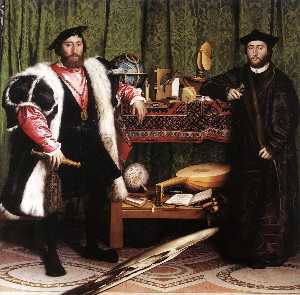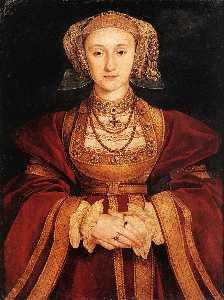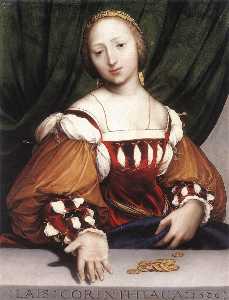Artist: Hans Holbein The Younger
Style: Northern Renaissance
Topic: Scenes
Technique: Oil
The Ambassadors (1533) is a painting by Hans Holbein the Younger in the National Gallery, London. As well as being a double portrait, the painting contains a still life of several meticulously rendered objects, the meaning of which is the cause of much debate. It is also a much-cited example of anamorphosis in painting. Although a German-born artist who spent much time in England, Holbein displayed the influence of Early Netherlandish painters in this work. This influence can be noted most outwardly in the use of oil paint, the use of which for panel paintings had been developed a century before in Early Netherlandish painting. What is most "Flemish" of Holbein's use of oils is his use of the medium to render meticulous details that are mainly symbolic: as Van Eyck and the Master of Flemalle used extensive imagery to link their subjects to divinity, Holbein used symbols to link his figures to the age of exploration.
Artist |
|
|---|---|
Download |
|
Permissions |
Free for non commercial use. See below. |
Hans Holbein The Younger – Most viewed artworks
|
This image (or other media file) is in the public domain because its copyright has expired. However - you may not use this image for commercial purposes and you may not alter the image or remove the watermark. This applies to the United States, Canada, the European Union and those countries with a copyright term of life of the author plus 70 years.
|















 Note that a few countries have copyright terms longer than 70 years: Mexico has 100 years, Colombia has 80 years, and Guatemala and Samoa have 75 years. This image may
not be in the public domain in these countries, which moreover do not implement the
Note that a few countries have copyright terms longer than 70 years: Mexico has 100 years, Colombia has 80 years, and Guatemala and Samoa have 75 years. This image may
not be in the public domain in these countries, which moreover do not implement the